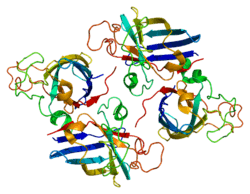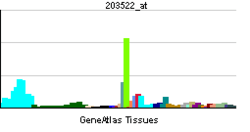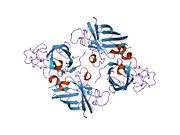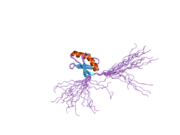CCS (gene)
| View/Edit Human | View/Edit Mouse |
Copper chaperone for superoxide dismutase is a metalloprotein that is responsible for the delivery of Cu to superoxide dismutase (SOD1).[3] CCS is a 54kDa protein that is present in mammals and most eukaryotes including yeast. The structure of CCS is composed of three distinct domains that are necessary for its function.[4][5] Although CCS is important for many organisms, there are CCS independent pathways for SOD1, and many species lack CCS all together, such as C. elegans.[5] In humans the protein is encoded by the CCS gene.[6][7]
Structure and function
CCS is composed of three domains.[3] Domain I is located on the N-terminus and contains the MXCXXC Cu binding sequence.[3] It has been determined to be necessary for function of CSS but its specific role is currently unknown.[3] The structure of domain II greatly resembles that of SOD1 which allows it to perform the function of binding to SOD1.[3] Domain III contains a CXC Cu binding motif and performs the Cu insertion and subsequent disulfide oxidation of SOD1.[3]
When CCS docks to SOD1, cysteine 244 of CCS and 57 of SOD1 form a disulfide linkage.[4] This disulfide bond is then transferred to form a disulfide bridge between cysteine 57 and 146 of SOD1.[4] CCS's catalytic oxidation of SOD1's disulfide bridge can only be performed in the presence of oxygen.[4] Furthermore, the disulfide linkage of SOD1 can be performed without the presence of CCS but requires oxygen and is much slower.[4] Additionally, CCS is proposed to help the proper folding of SOD1 by binding in the apo-state.[4]
As well as SOD1, CCS (gene) has been shown to interact with APBA1.[8]
Localization
CCS is localized in the nucleus, cystosol, and mitochondrial intermembrane space.[5] CCS is imported to the mitochondria by Mia40 and Erv1 disulfide relay system.[5] The cysteine 64 of CCS Domain I generates a disulfide intermediate with Mia40.[5] This disulfide bond is transferred to link cysteine 64 and 27 of CCS, stabilizing the protein in the mitochondrial intermembrane space where it delivers Cu to the Cu-less apo-SOD1.[4][5]
Role in copper homeostasis
In mammals cellular Cu levels are regulated by CCS's interaction with the 26S proteasome.[5] During times of Cu excess CCS delivers Cu to XIAP and primes the complex for auto-ubiquitination and subsequent degradation.[5] Interestingly, expression of SOD1 is not modified by Cu availability but by CCS ability to deliver Cu.[5] Knockouts of CCS (Δccs) show 70-90% decrease in SOD1 activity as well as increased expression of Cu binding proteins, namely, MT-I, MT-II, ATOX1, COX17, ATP7A to, presumably, reduce the amount of free Cu.[5]
Cells with CCS mutants have been shown to display ALS like symptoms.[4] Moreover, SOD1 mutants that have altered interactions with CCS have been shown to display misfolding and aggregation.[4]
References
- ↑ "Human PubMed Reference:".
- ↑ "Mouse PubMed Reference:".
- 1 2 3 4 5 6 Fukai T, Ushio-Fukai M (Sep 2011). "Superoxide dismutases: role in redox signaling, vascular function, and diseases". Antioxidants & Redox Signaling. 15 (6): 1583–1606. doi:10.1089/ars.2011.3999. PMID 21473702.
- 1 2 3 4 5 6 7 8 9 Son M, Elliott JL (Jan 2014). "Mitochondrial defects in transgenic mice expressing Cu,Zn superoxide dismutase mutations: the role of copper chaperone for SOD1". Journal of the Neurological Sciences. 336 (1-2): 1–7. doi:10.1016/j.jns.2013.11.004. PMID 24269091.
- 1 2 3 4 5 6 7 8 9 10 Nevitt T, Ohrvik H, Thiele DJ (Sep 2012). "Charting the travels of copper in eukaryotes from yeast to mammals". Biochimica et Biophysica Acta. 1823 (9): 1580–1593. doi:10.1016/j.bbamcr.2012.02.011. PMID 22387373.
- ↑ Culotta VC, Klomp LW, Strain J, Casareno RL, Krems B, Gitlin JD (Sep 1997). "The copper chaperone for superoxide dismutase". The Journal of Biological Chemistry. 272 (38): 23469–72. doi:10.1074/jbc.272.38.23469. PMID 9295278.
- ↑ "Entrez Gene: CCS copper chaperone for superoxide dismutase".
- ↑ McLoughlin DM, Standen CL, Lau KF, Ackerley S, Bartnikas TP, Gitlin JD, Miller CC (Mar 2001). "The neuronal adaptor protein X11alpha interacts with the copper chaperone for SOD1 and regulates SOD1 activity". The Journal of Biological Chemistry. 276 (12): 9303–7. doi:10.1074/jbc.M010023200. PMID 11115513.
Further reading
- Casareno RL, Waggoner D, Gitlin JD (Sep 1998). "The copper chaperone CCS directly interacts with copper/zinc superoxide dismutase". The Journal of Biological Chemistry. 273 (37): 23625–8. doi:10.1074/jbc.273.37.23625. PMID 9726962.
- Rothstein JD, Dykes-Hoberg M, Corson LB, Becker M, Cleveland DW, Price DL, Culotta VC, Wong PC (Jan 1999). "The copper chaperone CCS is abundant in neurons and astrocytes in human and rodent brain". Journal of Neurochemistry. 72 (1): 422–9. doi:10.1046/j.1471-4159.1999.0720422.x. PMID 9886096.
- Rae TD, Schmidt PJ, Pufahl RA, Culotta VC, O'Halloran TV (Apr 1999). "Undetectable intracellular free copper: the requirement of a copper chaperone for superoxide dismutase". Science. 284 (5415): 805–8. doi:10.1126/science.284.5415.805. PMID 10221913.
- Lamb AL, Wernimont AK, Pufahl RA, O'Halloran TV, Rosenzweig AC (Feb 2000). "Crystal structure of the second domain of the human copper chaperone for superoxide dismutase". Biochemistry. 39 (7): 1589–95. doi:10.1021/bi992822i. PMID 10677207.
- Moore SD, Chen MM, Cox DW (2000). "Cloning and mapping of murine superoxide dismutase copper chaperone (Ccsd) and mapping of the human ortholog". Cytogenetics and Cell Genetics. 88 (1-2): 35–7. doi:10.1159/000015480. PMID 10773661.
- Bartnikas TB, Waggoner DJ, Casareno RL, Gaedigk R, White RA, Gitlin JD (May 2000). "Chromosomal localization of CCS, the copper chaperone for Cu/Zn superoxide dismutase". Mammalian Genome. 11 (5): 409–11. doi:10.1007/s003350010078. PMID 10790544.
- Rae TD, Torres AS, Pufahl RA, O'Halloran TV (Feb 2001). "Mechanism of Cu,Zn-superoxide dismutase activation by the human metallochaperone hCCS". The Journal of Biological Chemistry. 276 (7): 5166–76. doi:10.1074/jbc.M008005200. PMID 11018045.
- McLoughlin DM, Standen CL, Lau KF, Ackerley S, Bartnikas TP, Gitlin JD, Miller CC (Mar 2001). "The neuronal adaptor protein X11alpha interacts with the copper chaperone for SOD1 and regulates SOD1 activity". The Journal of Biological Chemistry. 276 (12): 9303–7. doi:10.1074/jbc.M010023200. PMID 11115513.
- Silahtaroglu AN, Brondum-Nielsen K, Gredal O, Werdelin L, Panas M, Petersen MB, Tommerup N, Tümer Z (Apr 2002). "Human CCS gene: genomic organization and exclusion as a candidate for amyotrophic lateral sclerosis (ALS)". BMC Genetics. 3: 5. doi:10.1186/1471-2156-3-5. PMC 107843
 . PMID 11991808.
. PMID 11991808. - Bertinato J, L'Abbé MR (Sep 2003). "Copper modulates the degradation of copper chaperone for Cu,Zn superoxide dismutase by the 26 S proteosome". The Journal of Biological Chemistry. 278 (37): 35071–8. doi:10.1074/jbc.M302242200. PMID 12832419.
- Silahtaroglu AN, Jensen LR, Harboe TL, Horn P, Bendixen C, Tommerup N, Tümer Z (Aug 2004). "Sequencing and mapping of the porcine CCS gene". Animal Genetics. 35 (4): 353–4. doi:10.1111/j.1365-2052.2004.01150.x. PMID 15265083.
- Jin J, Smith FD, Stark C, Wells CD, Fawcett JP, Kulkarni S, Metalnikov P, O'Donnell P, Taylor P, Taylor L, Zougman A, Woodgett JR, Langeberg LK, Scott JD, Pawson T (Aug 2004). "Proteomic, functional, and domain-based analysis of in vivo 14-3-3 binding proteins involved in cytoskeletal regulation and cellular organization". Current Biology. 14 (16): 1436–50. doi:10.1016/j.cub.2004.07.051. PMID 15324660.
- Stasser JP, Eisses JF, Barry AN, Kaplan JH, Blackburn NJ (Mar 2005). "Cysteine-to-serine mutants of the human copper chaperone for superoxide dismutase reveal a copper cluster at a domain III dimer interface". Biochemistry. 44 (9): 3143–52. doi:10.1021/bi0478392. PMID 15736924.
- Duquesne AE, de Ruijter M, Brouwer J, Drijfhout JW, Nabuurs SB, Spronk CA, Vuister GW, Ubbink M, Canters GW (Jul 2005). "Solution structure of the second PDZ domain of the neuronal adaptor X11alpha and its interaction with the C-terminal peptide of the human copper chaperone for superoxide dismutase". Journal of Biomolecular NMR. 32 (3): 209–18. doi:10.1007/s10858-005-7333-1. PMID 16132821.
- Caruano-Yzermans AL, Bartnikas TB, Gitlin JD (May 2006). "Mechanisms of the copper-dependent turnover of the copper chaperone for superoxide dismutase". The Journal of Biological Chemistry. 281 (19): 13581–7. doi:10.1074/jbc.M601580200. PMID 16531609.




